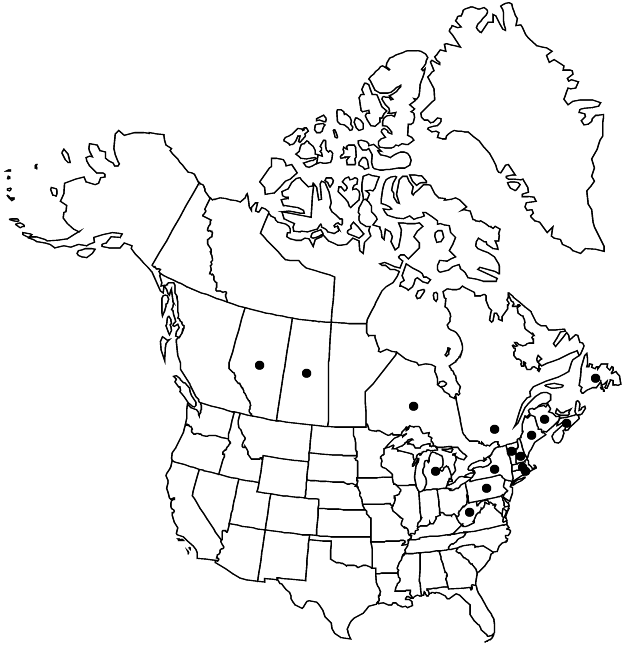Difference between revisions of "Fagopyrum tataricum"
Fruct. Sem. Pl. 2: 182. 1790.
FNA>Volume Importer |
imported>Volume Importer |
||
| (3 intermediate revisions by 2 users not shown) | |||
| Line 8: | Line 8: | ||
}} | }} | ||
|common_names=Tartary or green buckwheat;India-wheat;sarrasin de Tartarie | |common_names=Tartary or green buckwheat;India-wheat;sarrasin de Tartarie | ||
| + | |special_status={{Treatment/ID/Special_status | ||
| + | |code=I | ||
| + | |label=Introduced | ||
| + | }} | ||
|basionyms={{Treatment/ID/Basionym | |basionyms={{Treatment/ID/Basionym | ||
|name=Polygonum tataricum | |name=Polygonum tataricum | ||
|authority=Linnaeus | |authority=Linnaeus | ||
| + | |rank=species | ||
|publication_title=Sp. Pl. | |publication_title=Sp. Pl. | ||
|publication_place=1: 364. 1753 | |publication_place=1: 364. 1753 | ||
| Line 29: | Line 34: | ||
|elevation=0-1000 | |elevation=0-1000 | ||
|distribution=Alta.;N.B.;Nfld. and Labr. (Nfld.);N.S.;Ont.;Que.;Sask.;Maine;Mass.;Mich.;N.H.;N.Y.;Pa.;R.I.;Vt.;W.Va.;Asia (China);introduced in Europe. | |distribution=Alta.;N.B.;Nfld. and Labr. (Nfld.);N.S.;Ont.;Que.;Sask.;Maine;Mass.;Mich.;N.H.;N.Y.;Pa.;R.I.;Vt.;W.Va.;Asia (China);introduced in Europe. | ||
| + | |introduced=true | ||
|discussion=<p><i>Fagopyrum tataricum</i> is homostylous and self-pollinating. Cultivated plants appear to be most closely related to the wild ones in southwestern Sichuan, China. Tartary buckwheat is a less important crop plant and is encountered less frequently in the flora area than is <i>F. esculentum</i>. It is cultivated in mountainous areas of Asia and elsewhere (C. G. Campbell 1997).</p> | |discussion=<p><i>Fagopyrum tataricum</i> is homostylous and self-pollinating. Cultivated plants appear to be most closely related to the wild ones in southwestern Sichuan, China. Tartary buckwheat is a less important crop plant and is encountered less frequently in the flora area than is <i>F. esculentum</i>. It is cultivated in mountainous areas of Asia and elsewhere (C. G. Campbell 1997).</p> | ||
|tables= | |tables= | ||
| Line 38: | Line 44: | ||
-->{{#Taxon: | -->{{#Taxon: | ||
name=Fagopyrum tataricum | name=Fagopyrum tataricum | ||
| − | |||
|authority=(Linnaeus) Gaertner | |authority=(Linnaeus) Gaertner | ||
|rank=species | |rank=species | ||
| Line 53: | Line 58: | ||
|publication title=Fruct. Sem. Pl. | |publication title=Fruct. Sem. Pl. | ||
|publication year=1790 | |publication year=1790 | ||
| − | |special status= | + | |special status=Introduced |
| − | |source xml=https:// | + | |source xml=https://bitbucket.org/aafc-mbb/fna-data-curation/src/2e0870ddd59836b60bcf96646a41e87ea5a5943a/coarse_grained_fna_xml/V5/V5_1174.xml |
|subfamily=Polygonaceae subfam. Polygonoideae | |subfamily=Polygonaceae subfam. Polygonoideae | ||
|genus=Fagopyrum | |genus=Fagopyrum | ||
Latest revision as of 22:08, 5 November 2020
Stems ascending or erect, yelloish green, sometimes red-tinged, sparingly branched, (10–)30–80(–100) cm. Leaves: ocrea brownish hyaline, loose, funnel-form, 5–11 mm, margins truncate to obtuse, eciliate, glabrous or puberulent proximally; petiole (0.5–)1–7 cm, usually puberulent adaxially; blade palmately veined with 7–9 primary basal veins, broadly triangular to broadly hastate, 2–7 × 2–8 cm, base truncate or cordate to sagittate, margins ciliolate, apex acute to acuminate. Inflorescences axillary, racemelike, 2–10 cm, not crowded at stem apices; peduncle 1–6 cm, puberulent in lines. Pedicels ascending or recurved, 1–3 mm. Flowers often cleistogamous, homostylous; perianths green with whitish margins; tepals triangular to ovate, 1.5–3 mm, margins entire, apex obtuse to acute; stamens ca. 1/2 as long as perianth; styles 0.1–0.4 mm; stigmas purplish. Achenes uniformly gray or, infrequently, mottled with blackish spots medially, bluntly 3-gonous, 5–6 × 3–5 mm, faces irregularly rugose, angles usually obscure in proximal 1/2, more conspicuous in distal 1/2, unwinged, often sinuate-dentate. 2n = 16 (China).
Phenology: Flowering Jun–Sep; fruiting Jul–Nov.
Habitat: Cultivated as grain crop and green manure, waif in waste places, disturbed ground, and field margins, rarely persisting
Elevation: 0-1000
Distribution

Introduced; Alta., N.B., Nfld. and Labr. (Nfld.), N.S., Ont., Que., Sask., Maine, Mass., Mich., N.H., N.Y., Pa., R.I., Vt., W.Va., Asia (China), introduced in Europe.
Discussion
Fagopyrum tataricum is homostylous and self-pollinating. Cultivated plants appear to be most closely related to the wild ones in southwestern Sichuan, China. Tartary buckwheat is a less important crop plant and is encountered less frequently in the flora area than is F. esculentum. It is cultivated in mountainous areas of Asia and elsewhere (C. G. Campbell 1997).
Selected References
None.